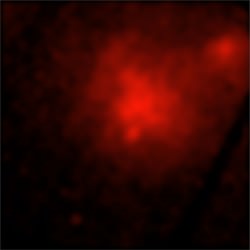[/caption]
Abell 2744, shown above in a composite of images from the Hubble Space Telescope, the ESO’s Very Large Telescope and NASA’s Chandra X-ray Observatory, is one of the most complex and dramatic collisions ever seen between galaxy clusters.

Dubbed “Pandora’s Cluster”, this is a region 5.9 million light-years across located 3.5 billion light-years away. Many different kinds of structures are found here, shown in the image as different colors. Data from Chandra are colored red, showing gas with temperatures in the millions of degrees. Dark matter is shown in blue based on data from Hubble, the European Southern Observatory’s VLT array and Japan’s Subaru telescope. Finally the optical images showing the individual galaxies have been added.
Even though there are many bright galaxies visible in the image, most of the mass in Pandora’s Cluster comes from the vast areas of dark matter and extremely hot gas. Researchers made the normally invisible dark matter “visible” by identifying its gravitational effects on light from distant galaxies. By carefully measuring the distortions in the light a map of the dark matter’s mass could be created.
Galaxy clusters are the largest known gravitationally-bound structures in the Universe, and Abell 2744 is where at least four clusters have collided together. The vast collision seems to have separated the gas from the dark matter and the galaxies themselves, creating strange effects which have never been seen together before. By studying the history of events like this astronomers hope to learn more about how dark matter behaves and how the different structures that make up the Universe interact with each other.
Check out this HD video tour of Pandora’s Cluster from the team at Chandra:
Read more on the Chandra web site or in the NASA news release.
Image credit: X-ray: NASA/CXC/ITA/INAF/J.Merten et al, Lensing: NASA/STScI; NAOJ/Subaru; ESO/VLT, Optical: NASA/STScI/R.Dupke.
___________________
Jason Major is a graphic designer, photo enthusiast and space blogger. Visit his website Lights in the Dark and follow him on Twitter @JPMajor or on Facebook for the most up-to-date astronomy awesomeness!


It makes me feel very small. It would take me several lifetimes to travel there.
…like on the order of 500 million lifetimes.
If you were a photon, you wouldn’t feel time passing by. You would reach your destiny instantaneously.
Photons have all the fun; stasis in between interactions, life as creation then death. … oh, maybe not so fun after all. “The Road is The Goal”, perhaps.
Not sure how long your ‘lifetime’ is expected to be but with the cluster, at 3.5 BILLION light years away, best you pack a big lunch, even if you have mastered the speed of light.Send a card when you get there!
Another brilliant win for DM! =D
That several clusters collide should not be surprising AFAIU. Then it must be the timing that makes it rare; within 350 My according to the video. It is Murphy’s law on the cosmic scale (aka the law of shit): “if shit can happen, shit will happen.”
This is pretty good evidence for dark matter. It repeats the observations of the Bullet cluster. We just now have to perform the proper measurements to determine just what DM is.
LC